Towing a trailer requires more skill from you as a driver, and puts more strain on your car. In this article we’ll discuss the skills you will need to develop, what the requirements are for your car, what should you watch out for, and how you should maintain your trailer.
You can also do safe load training online which covers cars, vans, utes and pickups, roof racks and more.
Licence restrictions
If you are on a learner or restricted licence (class 1) you can tow a trailer, but the combined weight of the vehicle, trailer and load must not exceed 4500kg. When you get your full licence the combined weight can be up to 6000kg.
If you have a restricted or full car licence you can drive an agricultural tractor-trailer combination of up to 25,000kg that’s being used for agricultural purposes as long as you do not exceed 40kph.
On a full car licence you can also drive the same combination at up to 30kph for any purpose (i.e. including non-agricultural.
What is a trailer?
In New Zealand a light trailer is defined as any trailer less than 3500kg when loaded. All trailers must have a current Warrant of Fitness and registration, with the licence label and WoF label placed on the back of the trailer near the number plate. To get a WoF the trailer must be in generally good condition with no rust or fatigue around the key safety areas, and have the following equipment in working order:
- A red reflector at each side on the rear
- Mudguards
- Legal tyres – the minimum tread depth is 1.5mm, but bear in mind that grip diminishes rapidly once your tyres have less than 3mm
- White lights at the front (each side) if the trailer is wider than 2 metres so that oncoming traffic can see how wide it is
- A coupling and safety chain that is strong enough to take the load
- Indicators at either side on the back
- At least one red light either side of the trailer to indicate how wide it is
- Two red stop lights if the car’s signals can’t be seen
- A number plate
- A socket to get power to the lights and, if fitted, brakes
Types of trailer
There are general purpose trailers as well as trailers specific for one or two purposes. The following are the main types of trailers you will encounter on the road.
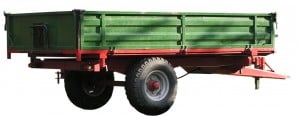 Flat-bed trailer: these are generally able to be hired from petrol stations and the like. They have a flat deck with low sides and sometimes have high cage sides. The rear of the trailer usually has a gate that folds down and/or a gate and cage that opens to one side. They may also be a tipper trailer where the back tips downwards to aid with unloading materials.
Flat-bed trailer: these are generally able to be hired from petrol stations and the like. They have a flat deck with low sides and sometimes have high cage sides. The rear of the trailer usually has a gate that folds down and/or a gate and cage that opens to one side. They may also be a tipper trailer where the back tips downwards to aid with unloading materials.- Box trailers: these also include furniture trailers. They are smaller covered trailers that are enclosed with a lockable door or gate at the rear. While they’re often used for moving furniture and smaller loads such as boxes, they can also be used for small motorsport teams for karting, and for tradespeople to transport equipment
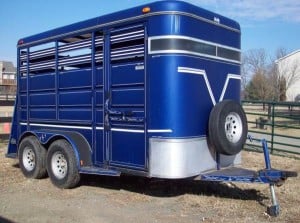 Horse float: this is a custom trailer that is designed to carry one or two horses. They usually have a clear perspex window on the front so that the horse can see where they are going, and a ramp at the rear to allow the horses to embark
Horse float: this is a custom trailer that is designed to carry one or two horses. They usually have a clear perspex window on the front so that the horse can see where they are going, and a ramp at the rear to allow the horses to embark- Vehicle trailers: these come in several types which may allow you to carry two- or four-wheel vehicles. Car trailers will have two ramps and often some tipping ability; motorbike trailers may have one or two ramps and could have special fixtures to allow bikes to stay upright. Both are likely to have specific areas to tie down the vehicles to stop them moving on the trailer.
- Caravans, camping trailers and pop-up campers: a caravan is the largest of these, being a full-sized trailer. Camping trailers and pop-up caravans are compacted versions which expand as you need them and therefore offer less wind resistance.
- Boat trailers: a boat trailer usually has a central V to take the boat’s hull, and a winch at the front to wind the boat in. They can also be built to accommodate one or more jetskis. The V will usually be padded to avoid damage to the hull. The whole trailer will be built of galvanised components which resist rust well.
- Agricultural trailers – specific trailers for fertiliser spreading, carrying silage, bales, etc
- Specialised trailers – trailer that serve one or more specific purposes for an industry, e.g. a cherry picker
- Heavy vehicles pull either a semitrailer or b-train which are coupled using a fifth wheel, or a pull or full trailer which is usually coupled using a bolt and pin coupling.
Braked vs unbraked
A braked trailer has brakes on the wheels of the trailer that are activated when you activate the car’s brakes. Some trailers’ brakes can be activated separately from the car’s brakes.
An unbraked trailer does not have brakes and the usual maximum gross weight that the manufacturer recommends for the trailer and load is around 750kg, but check the towing vehicle’s owner’s manual. A trailer over 2001kg must have service brakes and either a breakaway brake or two safety chains.
Connecting the trailer
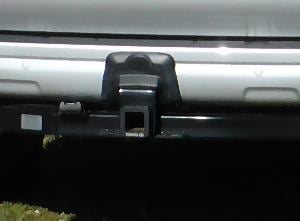
A trailer will have either tow coupling (tow hitch – as shown) or a tow ball, a safety chain and electrical connections for lights and, if fitted, brakes.
The couplings and tow balls will have a rating for the maximum load and this is marked on the coupling itself.
- Class I: up to 910kg/2000 pounds
- Class II: up to 1600kg/3500 pounds
- Class III: up to 2300kg/5000 pounds
- Class IV: up to 4500kg/10000 pounds (shown left)
You must not tow any more than one trailer or vehicle at a time.
Loading the trailer
Trailer loads must not extend more than four metres behind the rear axle. Any load that extends more than one metre behind the trailer must have a white flag, or an orange, red or yellow fluorescent flag tied to the end that is at least 40x30cm in size. The load must be secured to the trailer and must not drag on the ground. The load can extend in front of the trailer.
The maximum width of the trailer and load is 2.55m (1.275m either side of the centre of the trailer.
A trailer’s load must be distributed evenly. An uneven load will cause the trailer to behave unpredictably and it will affect the car’s handling more severely.
The trailer’s load must not lift the tow bar of the towing car. Ideally it will exert around 10% of its weight on the tow ball, and you should have 50-60% of the weight of the load forward of the axle.
Extra forces on your car
The trailer will exert forces on your car that will make it feel very different to drive, especially if you have a dynamic load like a horse. When you brake, the trailer will exert force forwards the back of the car. An unbraked trailer is completely relying on this force for braking, whereas a braked trailer has its own brakes to help slow it down.
When you are accelerating the trailer resists this acceleration, slowing your ability to pick up speed.
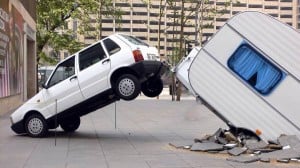
The trailer will also exert some downwards force on the tow ball or tow coupling. This force should never be too much (usually less than 250kg), and should never be a negative force (i.e. a lift) as this is dangerous – more about this below.
When you are moving, the trailer is at the mercy of a number of other forces imparted by the road surface and weather.
Many electric vehicles (EVs) are capable of towing, but it’s essential to check with the manufacturer’s documentation. For example, a Nissan Leaf cannot tow.
Bumps, dips and uneven surfaces
Many simple trailers have no suspension, simply relying on the tyre sidewalls to provide some cushioning. They tend to bounce around more over bumps and this can cause the load to shift if it is not secured properly. If you have driven over a particularly bumpy piece of road it’s a good idea to stop and check that the load hasn’t shifted. A load shifting mid-corner can tip a trailer on its side.
Even trailers with suspension tend to have unsophisticated leaf-spring setups.
Wind
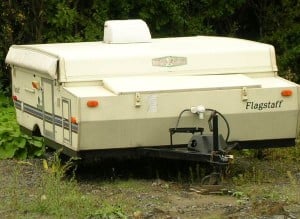
Strong crosswinds can be problematic for high-sided box trailers and horse floats. It will be particularly noticeable if you drive from out of a shaded area into an area with a strong crosswind, or, for example, over somewhere like the Harbour Bridge in Auckland which is more exposed. Unexpected gusts of wind can move the trailer around and that will also move your car.
Headwinds, especially on unaerodynamic trailers, can make it more difficult to maintain speed going uphill, and make it more difficult to lose speed going downhill – beware of brake fade. More aerodynamic trailers such as the pop-up camper shown are less affected.
Type of load
Tall loads with a high centre of gravity, such as horses and large boats, require much slower cornering than low, flat, static loads such as aggregates or chopped logs.
Can your car tow a trailer?
Check with your vehicle manufacturer whether it’s possible to fit a tow bar or tow coupling. Generally, most cars, including sports cars, can have a custom tow coupling made, although they may not be able to tow very heavy loads. The ability for a vehicle to tow a trailer and load depends on a number of factors such as:
- chassis strength – the chassis must be strong enough not to stretch when towing
- vehicle’s weight – the vehicle must be heavy enough to control the forces exerted by the trailer
- strength of the gearbox – the gearbox and clutch (if manual) must be strong enough to take the extra resistance provided by the trailer
- power and torque of the engine – there must be enough horsepower and turning force (torque) to allow the car to maintain speed up hills, and to get a large trailer moving
- how many driven wheels it has – two- or four-wheel drive influences the amount of grip available, and is mainly relevant for towing on wet or muddy surfaces such as for boats, horse floats and agricultural purposes.
Your car will usually have a rating for both braked and unbraked trailers. The maximum weight for an unbraked trailer and load is usually 750kg for a light vehicle (although, the legal maximum weight for an unbraked trailer is 2000kg). For a braked trailer and load the maximum weight can be up to 3500kg, but almost all cars will not be able to tow this amount, and it will only be large, powerful SUVs and utes that will get up to 3000-3500kg in towing capacity.
A smaller car is likely to top out at around 1200kg towing capacity, and a larger car around 2500kg.
Typically the vehicle’s brochure or handbook will have information similar to this for the Holden Colorado showing 3000kg for a braked trailer and 750kg for an unbraked trailer. Note that the gross combined vehicle weight is under 6000kg:
Towing (kg): Braked 3000, Unbraked 750
Maximum Front Axle Load (kg): 1450
Maximum Rear Axle Load (kg): 1600
Wading Depth (mm): 600
Roof Load (kg): 100
Curb Mass (kg): 2170
Gross Vehicle Mass (GVM) (kg): 2820
Gross Combined Vehicle Weight (GCVW) (kg): 5700
Load Carrying Capacity (kg): 650
Exceeding the towing capacity is dangerous because you can bend the chassis, or the car might not be heavy enough to exert enough control over the trailer.
If your car already has a tow bar fitted it will be either a factory model, or a third-party model. There will be marks on it to tell you what the maximum rating is.
Equipment required on your car
- An approved tow bar or tow coupling with safety chain and positive locking mechanism
- A working electrical connection for lights
Optional equipment for your car
- Additional mirrors
- Load equaliser (these help distribute the load more evenly and maintain normal suspension height)
- Better brake fluid and brake pads (if you tow large loads frequently)
- Additional oil cooler (if you tow frequently or live in a hilly area)
- Structural reinforcement
Types of tow coupling/tow bar
Your trailer must not exceed lower of the rating capacity of the tow bar or tow coupling, the maximum towing capacity of your car, the maximum towing capacity of the trailer, or the maximum weight bearing capacity of the tyres.
How to tow safely
As the trailer could be wider than your car, it could block rearward visibility from your wing mirrors. You should buy special mirror extensions to allow you to see behind you. Many trailer will also block your view out of the rear window.
When you are towing anything (this includes another vehicle) there must not be more than 4 metres gap between your car and what you are towing.
Because of the increased load on your car, the towing limit for a car or light truck with a trailer is 90kph, and if you are towing a motorbike, the maximum speed is 30kph (the motorbike must be mechanically disabled).
All towed vehicles and trailers must show a red light at the back at night, and if you are towing a disabled vehicle, its headlights must light up the towing connection.
If you are towing with a rope or strop as opposed to a rigid towing system like a tow coupling or tow bar, your maximum speed is 50kph.
Traction requirements
Consider the type of load you will be towing and where you will be towing it when you choose your car, or before you tow. If you are taking a boat to a boat ramp, boat ramps are slippery and a two-wheel drive car may not have enough grip to pull the extra weight of a boat out of the water. If you are launching from a beach, a two-wheel drive car may get bogged down in the sand, or may not have enough ground clearance, especially if loaded with other luggage.
Dangers when driving with a trailer
As well as the aforementioned crosswinds, you will need to:
- Allow greater distances to stop
- On long downhill stretches use the gears to slow your car down or you will overheat your brakes and end up with brake fade, which is very dangerous
- Be especially aware of loose stones on corners
- Allow greater distances to accelerate, and more time to overtake other vehicles
- Be careful of cutting in on another vehicle too early when you overtake
- Be aware that the trailer will cut any corner you take, therefore take a slightly wider line
- When reversing, get someone to stand outside of the car and guide you – backing a trailer is counter-intuitive when you first learn
- Avoid sharp movements when driving as these can cause your trailer to start swaying or snaking. If this happens try to avoid touching the brakes unless absolutely necessary. If you can activate the trailer’s brakes separately, do this. The worst case scenario for you here is that the trailer tips on its side or jack-knifes. Newer cars come with trailer stabilisation systems that help prevent this.
- Look at least eight seconds ahead to give yourself plenty of time to react.
- Take more frequent breaks because driving with a trailer is more fatiguing than driving without a trailer.
- Take special care when parking that you can exit your car park easily and without endangering other motorists
- Take care when unhitching your trailer that it is not on a slope and at risk of running away.
Courteous towing
You will be an obstruction to other road users when you are towing, and you must not unreasonably impede their driving. This means that if there are passing bays, you must use them; if you can stay well left, then do so; in passing lanes, ensure that you are courteous and allow others to pass. If you are holding up a line of traffic you must stop periodically to let them past if the road doesn’t have passing areas – this is particularly important on roads such as the Thames/Coromandel coast road.
If you are following another slower vehicle, leave plenty of room – observe the four-second rule. For one, your braking distances will be longer, and two, other vehicles overtaking you need a safe place to pull in.
Safety checks
Before you tow:
- Check that the trailer is roadworthy, and that the vehicle’s towing system (and the vehicle) are roadworthy, too
- Ensure the brakes on your car, and on the trailer (if fitted) are working
- Check tyre pressures on the trailer. If you are pulling a heavy trailer you may need to put more air in your car tyres to compensate, although bear in mind this will also reduce the contact patch between your tyre and the road. Check with the tyre manufacturer for guidance
- If you don’t have self-leveling headlights, look for the headlight leveling switch in your car and angle them down so that you don’t dazzle other drivers
When you stop for breaks during your trip:
- Check the tow coupling and safety chain are still fastened securly
- Check all doors and gates are fastened
- Check all strops, tie-downs, ropes and bungee cords are connected and tight
- Check to see that the tyres look like they’re still inflated
- Check the load hasn’t moved
Now you know about towing, it’s important you know about brake fade. Click here to read how to prevent it.

